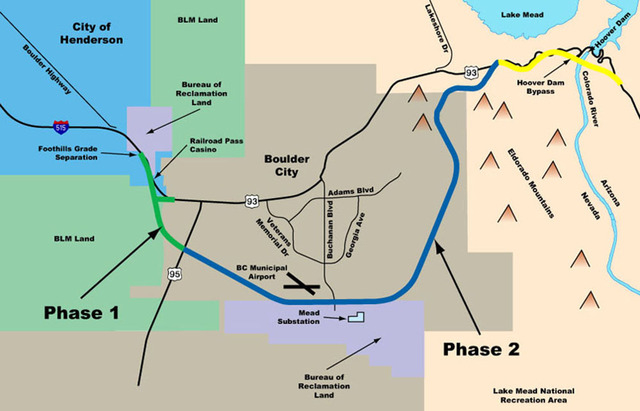
Interstate 11 construction, specifically the Boulder City bypass portion, is closer to becoming a reality after the Nevada and Arizona Transportation departments wrap up two years of extensive analysis of the project.
The June 26 meeting in Las Vegas was the final public session before the departments conclude the Intermountain West Corridor Study begun in summer 2012.
The study, expected to be competed this summer, details an interstate connecting Las Vegas and Phoenix.
Screening for the I-11 project includes studying legislation, trade, environmental sustainability, land use, cost and ability to connect with other highways.
The corridor will likely follow U.S. Highway 93 from Wickenburg, Ariz., through Kingman, Ariz., across the O’Callaghan-Tillman Memorial Bridge and through the soon-to-be constructed Boulder City bypass to Las Vegas.
Boulder City Public Works Director Scott Hansen said the next step is bidding, which takes place in October, assuming there are no further delays. The construction will boost Boulder City’s economy, he said.
“These construction workers have to go somewhere to get their Gatorades and snacks,” he said.
U.S. Sens. John McCain and Jeff Flake, both of Arizona, proposed an amendment seeking congressional support for I-11.
The proposed amendment to the Commerce, Justice, Science and Related Agencies Appropriations Act of 2015 expresses support for I-11 based on “significant enhancement for the western United States” for commerce, tourism, international trade, economic vitality and competitiveness on the global stage, according to the Arizona Transportation Department.
In addition, the amendment would support extending I-11 south to the Mexican border and north to the Canadian border.
Nevada Transportation Department spokesman Damon Hodge said talks about I-11 stretching from Mexico to Canada are at least a decade away.
As part of the study, Nevada and Arizona completed economic development outlines for specific industry clusters, such as advanced manufacturing, agriculture, renewable energy, transportation and logistics.
The Nevada Transportation Department used a strategic approach to evaluate the potential return on the I-11 investment. Its study concluded that the project would cost $12 billion to $13 billion, but the income from travel would range from $26 billion to $39 billion, and the economic benefits would be $4 billion to $24 billion.
“Not only will Interstate 11 create jobs in Arizona and Nevada, it also will integrate and increase the global competitiveness of the entire Southwest region,” Arizona Gov. Jan Brewer said in an email.
The Nevada Transportation Department said the potential $24 billion benefit would generate 240,000 jobs during the entire construction.
Hansen said he was pleased when he heard that the Boulder City bypass was scheduled to be completed by 2017, citing the asbestos findings last year that delayed the process by several months.
“It will feel even better when they start to move the dirt and it looks like a freeway,” he said.
The Regional Transportation Commission is in charge of the 12½ miles closest to the Arizona border, while the Nevada Transportation Department supervises the other 2½ miles. The 15-mile project is expected to cost $600 million.
Hodge said his department has received thousands of comments about I-11 throughout the study, including several from Henderson residents who expressed their concerns during the June 26 meeting. Many residents were concerned about having a highway built in their backyard, he said.
Residents can log on to www.i11study.com to comment on the project.
“As we move forward and look at specific alignments, additional (public) meetings will be held,” Hodge said.